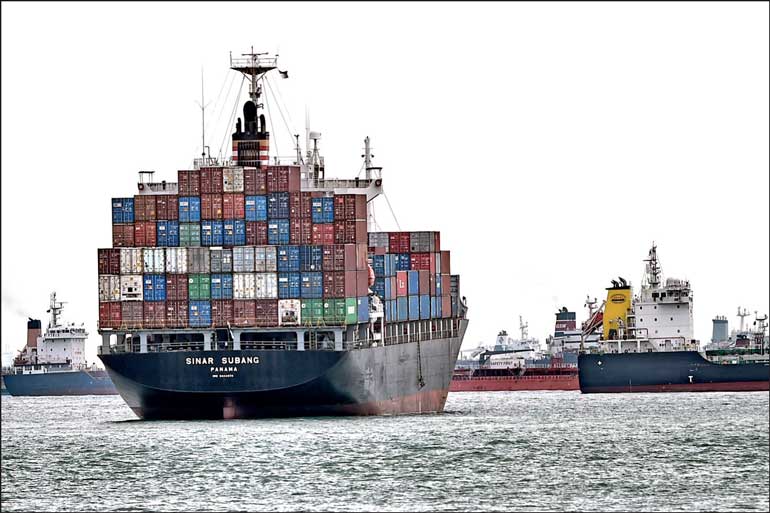Monday Apr 07, 2025
Monday Apr 07, 2025
Monday, 13 February 2023 00:25 - - {{hitsCtrl.values.hits}}

In Sri Lanka’s case, export promotion must become an overarching economic policy objective
 On 4 February 2023, Sri Lanka celebrated its 75th anniversary of independence from British rule. With the country amid a crippling economic crisis and a fall in per capita income, Sri Lankans have mixed views on whether there was much to celebrate. Sri Lankans do agree, however, on the need to re-double policy efforts to tackle the economic crisis and build a prosperous and inclusive economy for future generations.
On 4 February 2023, Sri Lanka celebrated its 75th anniversary of independence from British rule. With the country amid a crippling economic crisis and a fall in per capita income, Sri Lankans have mixed views on whether there was much to celebrate. Sri Lankans do agree, however, on the need to re-double policy efforts to tackle the economic crisis and build a prosperous and inclusive economy for future generations.
An IMF program is necessary to stabilise the economy and enable Sri Lanka to borrow prudently from abroad again but no panacea. As China is yet to provide assurances on debt sustainability, IMF Board approval of a $ 3.9 billion IMF program over four years may take some time. Trading more with dynamic Asia economies is a complementary pathway for Sri Lanka to earn foreign exchange to pay for essential imports like food, fuel, medicines and inputs for export industries. Regional trade will also expose the Sri Lankan economy to competition to facilitate economic restructuring, improve resource allocation, provide economies of scale and a greater choice of goods for consumers.
My recent paper in an IMF book, ‘South Asia’s Path to Resilient Growth’1 argues that South Asia’s disappointing trade integration means trading more with dynamic East Asia makes economic sense. A strong base exists: since the 1990s, South Asia-East Asia trade and free trade agreements (FTAs) have gathered pace and are linked to India’s trade re-aligning towards East Asia through its Look East and Act East Policies, South Asia adopting economic reforms and China’s offshoring of global supply chains to the rest of Asia. Although from a small base, total merchandise trade between South Asia and East Asia (in US dollar terms) grew rapidly at about 10% annually between 1990 and 2018 to $ 332 billion in 2018. This figure can increase to nearly $ 500 billion over the next few years. The handful of FTAs linking economies in South Asia with East Asia is set to rise to 30 by 2030.
In addition, regional trade in Asia is recovering after the COVID-19 pandemic and has opened opportunities for South Asian economies to participate in global value chains and services trade.
What then needs to be done regionally and in Sri Lanka?
First, regional trade integration across Asia can be encouraged by gradually reducing barriers to goods and services trade. Import tariffs and murky non-tariff measures have risen in several South Asian economies since the 2008 global financial crisis – and never reversed. To get beyond this, South Asia’s trade opening should be calibrated with tax reforms as trade taxes account for much of government revenue in some economies. Adjustment financing to losing sectors to reallocate factors of production and re-training of workers, is also essential to promote gains from trade and mitigate income inequality.
In Sri Lanka’s case, export promotion must become an overarching economic policy objective. Key policy measures required include: ensuring a highly competitive exchange rate; undertaking gradual and transparent import tariff reforms geared to exports; implementing ‘stroke of the pen’ cutting red tape strangling exporting firms; and digitising customs and tax administration.
Second, improve the performance of special economic zones (SEZs) and invest in services SEZs to facilitate industrial clustering and exports. South Asia has over 600 SEZs in operation including in Cochin in India, Gwadar in Pakistan, Mirsarai in Bangladesh and Hambantota in Sri Lanka. However, these SEZs have a variable record measured by generating exports and jobs and fostering local linkages with the domestic economy. Improving SEZ processes and outcomes in South Asia requires ensuring macroeconomic and political stability, adopting good practice regulatory policies towards investors, providing reliable electricity and 5G broadband cellular technology, and upgrading worker skills.
Sri Lanka needs to follow suit. It also needs to streamline its generous fiscal incentives for investors. Fiscal incentives only matter on the margin in the locational decisions of multinationals, and long tax holidays deprives debt-ridden Sri Lanka of vital tax revenue. Furthermore, Sri Lanka should fine-tune plans for merging the state-run Board of Investment (BoI) and the Export Development Board (EDB) to create a single institution. As a part of this exercise, the management of existing export processing zones (EPZ) (e.g. those at Katunayake, Biyagama and Hambantota) should be hived off from the BoI and offered as a management contract on a transparent tender basis to international companies with a track record of managing SEZs. The new promotion institution can then concentrate on export and investor marketing and facilitation.
Third, pursue comprehensive FTAs to provide for regional rules-based trade to help insure against rising protectionist tendencies. South Asia is a relative latecomer to FTA-led regionalism. Nonetheless, the Japan-India FTA, the Sri Lanka-Singapore FTA and the Pakistan-Indonesia FTA are important intra-Asian agreements.
But details matter. Sri Lanka and the rest of South Asia should improve tariff preference use by better preparing business on navigating complex rules of origin in FTAs and including new trade issues relevant to global supply chains in future FTAs. Although India opted out of the RCEP talks in November 2019, it can join the agreement later. Having done FTAs with UAE and Australia in 2022 and in negotiations with the UK, India is pro-active in FTAs. If India joins RCEP, the rest of South Asia may be incentivised to join from a fear of being left out and suffering from trade diversion effects.
Sri Lanka has limited capacity and credibility in FTA negotiations. In such circumstances, a strategic approach maybe worthwhile. Sri Lanka needs to restore its tarnished reputation as a trusted FTA partner while building FTA negotiations capability through learning by doing. As an initial step, the country should enforce its troubled FTA with Singapore and upgrade its FTA with India to cover more trade in goods, trade in services, investment, trade facilitation and government procurement. Next would be an FTA with Bangladesh as Sri Lankan garment firms have already opened production facilities in that country in response to demands from their buyers and competitive wages.
Fourth, a reinvented trade-focused Bay of Bengal Initiative for Multi-Sectoral Technical and Economic Cooperation (BIMSTEC) can facilitate stronger trade and support smaller members. Political support exists as India and Thailand are emphasising BIMSTEC to foster South Asia and Southeast Asia cooperation. Practical measures include: better resourcing of the BIMSTEC Secretariat, pushing to conclude the long running BIMSTEC FTA, building trade policy capacity and introducing dialogue partner status to encourage open regionalism in Asia. Sri Lanka should support strengthening BIMSTEC and establish a national expert group to devise a plan to improve trade relations with BIMSTEC economies.
The bottom line is that regional trade in Asia is a growth opportunity for South Asia in an uncertain world economy. To realise this opportunity, alongside an IMF program, Sri Lanka needs to adopt reforms to usher in a more export-oriented, market-friendly economy. This means shifting from its comfort zone of an outdated inward-oriented, state-dominated economy. Doing so means improving the betting odds on Sri Lanka avoiding a lost development decade and untold misery for its people.
Footnote:
1https://www.imf.org/en/News/Seminars/Conferences/2023/01/010623-south-asia-book-launch-events-in-new-delhi
(The writer is Professorial Fellow in Economics and Trade, Gateway House, Mumbai and Senior Research Associate, ODI Global, London. The views expressed here are solely his.)